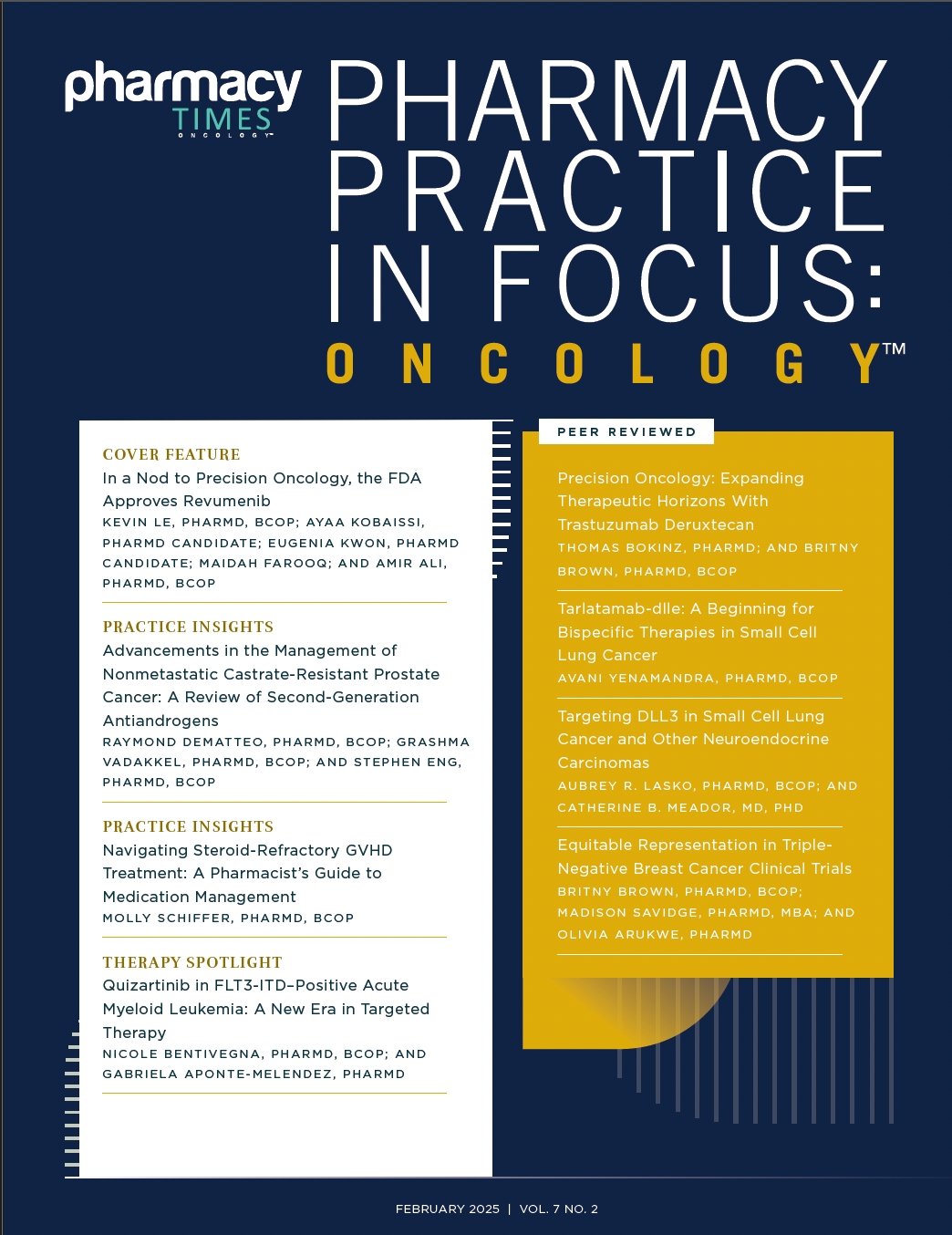Revumenib (Revuforj; Syndax Pharmaceuticals) is a novel therapy recently approved by the FDA as the first of its class for treating relapsed or refractory (R/R) acute leukemia associated with specific KMT2A gene rearrangements (KMT2Ar), also known as mixed-lineage leukemia.1 The drug is currently indicated for the treatment of R/R acute leukemia with a KMT2A translocation in adult and pediatric patients 1 year and older.2 Revumenib received both breakthrough therapy and orphan drug designations from the FDA, emphasizing its potential to address a significant unmet need for this rare and aggressive cancer type. These expedited pathways recognize the drug’s promising efficacy and safety profile in early trials and its potential to improve outcomes for patients lacking effective treatment options. Revumenib received FDA approval on November 15, 2024, and has been in the spotlight to assess its placement in standard of care. The novel mechanism of action of revumenib, a menin inhibitor, selectively targets the genetic drivers of KMT2Ar leukemia, distinguishing it from existing therapeutic modalities. With the emergence of this new therapeutic modality, pharmacists are integral to optimizing dosing and managing potential toxicities to ensure safe and effective treatment.3
Disease State Overview
Acute leukemia is a fast-progressing blood cancer originating in the bone marrow, where blood cells are produced and mature. The disease is marked by the uncontrolled proliferation of immature lymphocytes, a type of white blood cell, which disrupts the normal production and function of healthy blood cells. As leukemic cells multiply, they outcompete normal white blood cells, red blood cells, and platelets, leading to complications such as increased susceptibility to infections, anemia, and bleeding disorders. The cancer’s ability to circulate through the bloodstream enables it to spread rapidly to other areas, including the brain and various other organs. The term acute reflects the disease’s aggressive nature, as it progress quickly and becomes life-threatening without prompt treatment.4
It is estimated that more than 95% of patients with KMT2Ar acute leukemia have a KMT2A translocation, which is a type of rearrangement that occurs when part of one chromosome breaks and fuses to a different chromosome.4 It affects various types of leukemia in both pediatric and adult populations, accounting for approximately 10% of acute leukemia cases. This subset of leukemia presents significant treatment challenges, as standard treatment options such as traditional chemotherapy and hematopoietic cell transplantation often result in suboptimal outcomes, leading to relapse. The genetic abnormality contributes to an especially aggressive disease course, necessitating innovative therapeutic approaches to improve outcomes.5
Mechanism of Action and Clinical Context of Revumenib
Revumenib is an oral, small-molecule inhibitor that specifically targets menin, which is a protein that is essential for the pathologic interaction with the KMT2A protein. This interaction is a key driver of the leukemogenic process in KMT2Ar leukemia. By disrupting the menin-KMT2A interaction, revumenib interferes with the abnormal cellular signaling that fuels disease progression, offering a novel, targeted therapeutic approach that is distinct from traditional therapies.6
Currently, standard treatment for KMT2Ar leukemia involves intensive chemotherapy followed by hematopoietic stem cell transplantation. These approaches often yield suboptimal results, with high relapse rates and limited long-term survival. Until now, no targeted therapies have been available for KMT2Ar leukemia. Its introduction marks a significant advancement, providing a new, precision-based treatment option for patients with this debilitating mutation.2,6
Clinical Trial Review
Efficacy
R/R KMT2Ar acute leukemia is associated with a poor prognosis, with less than 10% of patients achieving remission with existing therapies. In the AUGMENT-101 phase 1/2 clinical trial (NCT04065399) interim analysis, treatment with revumenib showed significantly higher remission rates compared with historical controls, with a complete remission (CR) and CR with a partial hematologic recovery rate of 22.8% (95% CI, 12.7%-35.8%) and an overall response rate of 63.2%. The efficacy profile across age subgroups, including varying ages, lineages, prior venetoclax (Venclexta; AbbVie) use, and different KMT2A translocation partners, demonstrates broad applicability while emphasizing the treatment’s potential within precision oncology. These results stress the potential of revumenib monotherapy to clear leukemic blasts and allow patients to proceed to potentially curative allogeneic hematopoietic stem cell transplantation.6
Safety
Notable adverse events (AEs) to monitor with revumenib therapy include corrected QT interval (QTc) prolongation and differentiation syndrome. Specifically, revumenib contains a black box warning for differentiation syndrome, which is a severe reaction to anticancer therapy.2 In the AUGMENT-101 phase 2 trial interim analysis, QTc prolongation occurred in 25.5% of patients (grade 3, 13.8%; grade 4, 0%) and differentiation syndrome occurred in 27.7% of patients (grade 3, 14.9%; grade 4, 1.1%), with a median time to onset of 10 days, ranging between 3 and 41 days. Interruption of therapy due to differentiation syndrome and QTc prolongation occurred in 7.4% and 11.7% of patients, respectively; however, treatment was manageable with supportive care and dose adjustments. It is also pertinent to note that no treatment discontinuations occurred due to either QTc prolongation or differentiation syndrome. Furthermore, diarrhea, edema, febrile neutropenia, nausea, and vomiting are among the common AEs that occurred in more than 30% of patients.6 These findings highlight revumenib’s tolerability and manageable safety profile, particularly in a population whose current therapies are used with palliative intent.
The Pharmacist's Role
Pharmacists can play a pivotal role in the safe and effective administration of targeted therapies, such as revumenib. Prior to treatment initiation, it is essential to assess a patient’s blood counts and electrolyte and liver enzyme levels, as well as perform a baseline electrocardiogram because of the potential risk of QTc prolongation. The dosing of revumenib, a cytochrome P450 (CYP) 3A4 substrate, requires adjustment based on concomitant therapy only with strong CYP3A4 inhibitors, such as voriconazole (Vfend; Pfizer Inc) and posaconazole (Noxafil; Merck). The recommended dose for patients requiring concomitant use of CYP3A4 inhibitors is 160 mg (95 mg/m2 if < 40 kg) every 12 hours in 28-day cycles. Of note, dose adjustments are not necessary for patients on moderate CYP3A4 inhibitors, such as fluconazole (Diflucan; Pfizer Inc) and isavuconazonium sulfate (Cresemba; Astellas Pharma Inc), emphasizing the critical role of pharmacists in optimizing treatment regimens. Furthermore, the package insert explicitly advises against concurrent use of both strong and moderate CYP3A4 inducers because of potential reductions in revumenib efficacy and increases in QTc prolongation.2
For patients not requiring strong CYP3A4 inhibitors, the recommended dose is 270 mg (95 mg/m2 if < 40 kg) every 12 hours in 28-day cycles. Revumenib is available in 3 tablet strengths: 25 mg, 110 mg, and 160 mg. This dosing regimen requires 2 separate dosage strengths, resulting in distinct prescriptions, which may potentially increase patient financial burden. Pharmacists play a crucial role in exploring cost-saving strategies and facilitating patient access to medications. Additionally, a key clinical pearl is counseling patients on the importance of administering revumenib on an empty stomach or with a low-fat meal (eg, meals with approximately 400 calories, 25% or less fat) to optimize absorption.2
Although revumenib has demonstrated a tolerable safety profile, vigilant monitoring is essential to identify signs and symptoms of differentiation syndrome, QTc prolongation, and interactions with concurrent therapy that may exacerbate QTc prolongation. It is important for pharmacists to recognize the early signs and symptoms of differentiation syndrome for prompt management, as it can be life-threatening if left untreated. Key manifestations include pleuropericardial effusion, hypoxia, peripheral edema, fever, dyspnea, acute renal failure, and/or hypotension. Timely initiation of systemic corticosteroids is essential, along with therapy interruption if severe symptoms persist for more than 48 hours. Additionally, given the high incidence of nausea observed with revumenib, pharmacists can effectively prevent and address emetic episodes, drastically affecting patient quality of life. Monitoring potassium and magnesium levels is crucial in the setting of QTc prolongation. Pharmacists can be involved in correcting electrolyte abnormalities to prevent hypokalemia and hypomagnesemia, thereby reducing the risk of cardiac complications.2,3
About the Authors
Kevin Le, PharmD, BCOP, is a clinical pharmacist at the University of Southern California Norris Comprehensive Cancer Center in Los Angeles.
Ayaa Kobaissi is a 2025 PharmD candidate at the University of Southern California Alfred E. Mann School of Pharmacy and Pharmaceutical Sciences in Los Angeles.
Eugenia Kwon is a 2025 PharmD candidate at the University of Southern California Alfred E. Mann School of Pharmacy and Pharmaceutical Sciences in Los Angeles.
Maidah Farooq is a class of 2022 graduate from the University of California, Riverside, with a degree in biology.
Amir Ali, PharmD, BCOP, is a clinical pharmacist specialist at the University of Southern California (USC) Norris Comprehensive Cancer Center and an adjunct assistant professor of pharmacy practice at USC Alfred E. Mann School of Pharmacy and Pharmaceutical Sciences in Los Angeles.
All in all, pharmacists are essential in ensuring optimal dosing, effectively managing potential toxicities, and making necessary adjustments based on patient-specific factors and drug interactions, ultimately enhancing treatment efficacy and patient safety.
Accessibility and Future Considerations
The approval of revumenib marks a significant milestone in the treatment of a rare and aggressive subtype of acute leukemia, offering renewed hope to patients and their families. For health care professionals, staying informed about the latest clinical applications of revumenib is essential. Pharmacists, in particular, can play a key role in oncology by facilitating optimized, individualized therapy. This includes educating patients on the drug’s use and potential AEs, and ensuring adherence to treatment protocols in a safe manner, ultimately enhancing patient outcomes and advancing precision oncology.
In addition, preclinical and early-phase data suggest that combining revumenib with BCL2 inhibitors, such as venetoclax, FLT3 inhibitors, and hypomethylating agents, may result in higher remission rates. Ongoing trials, such as the phase 1/2 SAVE study (NCT05360160), are evaluating several treatment combinations, and studies combining revumenib with standard-of-care induction and consolidation chemotherapy are also being conducted.6
Treatment with revumenib has also shown promise in patients with NPM1-mutated (NPM1m) acute myeloid leukemia (AML), which is another challenging disease lacking approved targeted therapies.7 Recent top-line results from the AUGMENT-101 trial’s NPM1m AML cohort indicate that revumenib achieved significant clinical responses in R/R NPM1m AML, reinforcing its role in precision oncology.8
REFERENCES
1. Syndax announces FDA approval of Revuforj (revumenib), the first and only menin inhibitor to treat adult and pediatric patients with relapsed or refractory acute leukemia with a KMT2A translocation. News release. Syndax Pharmaceuticals. November 15, 2024. Accessed December 14, 2024. https://ir.syndax.com/news-releases/news-release-details/syndax-announces-fda-approval-revuforjr-revumenib-first-and-only
2. Revuforj. Prescribing information. Syndax Pharmaceuticals Inc; 2024. Accessed December 18, 2024. https://www.accessdata.fda.gov/drugsatfda_docs/label/2024/218944s000lbl.pdf
3. FDA approves revumenib for relapsed or refractory acute leukemia with a KMT2A translocation. FDA. November 15, 2024. Accessed December 14, 2024. https://www.fda.gov/drugs/resources-information-approved-drugs/fda-approves-revumenib-relapsed-or-refractory-acute-leukemia-kmt2a-translocation
4. Acute lymphoblastic leukemia treatment (PDQ)–patient version. National Cancer Institute. Updated August 21, 2024. Accessed December 14, 2024. https://www.cancer.gov/types/leukemia/patient/adult-all-treatment-pdq
5. Issa GC, Aldoss I, Thirman MJ, et al. Menin inhibition with revumenib for KMT2A-rearranged relapsed or refractory acute leukemia (AUGMENT-101). J Clin Oncol. 2025;43(1):75-84. doi:10.1200/JCO.24.00826
6. Meyer C, Larghero P, Almeida Lopes B, et al. The KMT2A recombinome of acute leukemias in 2023. Leukemia. 2023;37(5):988-1005. doi:10.1038/s41375-023-01877-1
7. Syndax announces positive pivotal topline results from relapsed or refractory mNPM1 AML cohort in AUGMENT-101 trial of revumenib. News release. Syndax Pharmaceuticals. November 12, 2024. Accessed December 23, 2024. https://ir.syndax.com/news-releases/news-release-details/syndax-announces-positive-pivotal-topline-results-relapsed-or
8. Syndax announces additional positive data for Revuforj (revumenib) from AUGMENT-101 trial in relapsed or refractory mNPM1 AML and BEAT AML frontline combination trial. News release. Syndax Pharmaceuticals. December 9, 2024. Accessed December 23, 2024. https://ir.syndax.com/news-releases/news-release-details/syndaxannounces-additional-positive-data-revuforjr-revumenib







